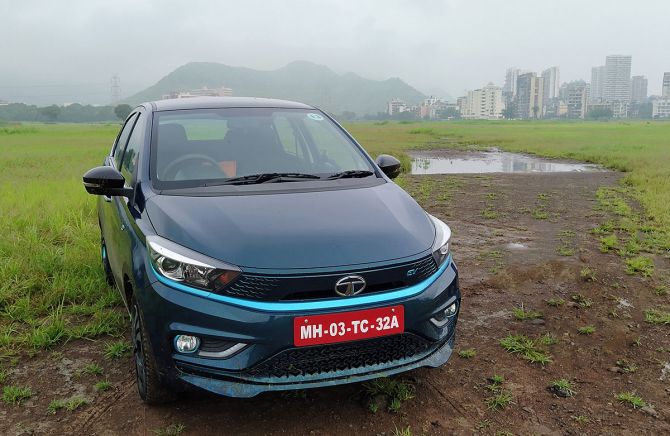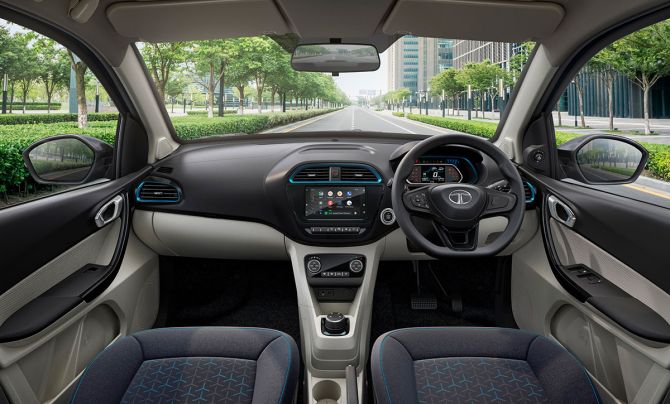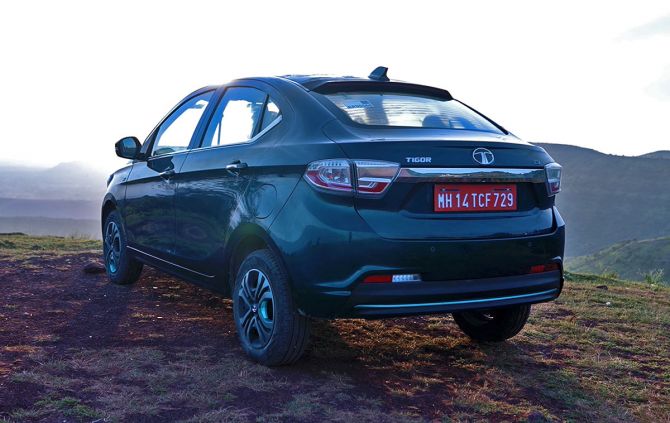Even though Tigor EV is one of the most affordable EVs in the sedan segment, auto enthusiasts feel the price is not justified as the interior sports the same old look of the Tigor petrol.
Read on to find out if buying Tigor EV actually makes sense.
Photographs and video by Hitesh Harisinghani and Rajesh Karkera/Rediff.com
At a time when fuel prices across the country are going through the roof with no sign of it moderating, electric vehicles seem the likely choice for car buyers who are looking at saving fuel costs.
And add to it the negligible maintenance of electric vehicles.
Continuing with this revolution with their 2nd offering in the EV segment, Tata Motors now offers the 2021 Tigor EV to its customers.
Tigor petrol with its style-back design has always been a stunner since its launch and it still is.
And it is this design that has been converted into an EV.
Tata Tigor EV (launched in 2018 and now called the Xpress T) was earlier available only for fleet cars and car hire services is now finally available for the retail end-user customer in a new 2021 updated version.

You may wonder why Tata Motors launched an 'updated' version.
Well, it's because the earlier one was not fun to drive and the driving range in one single charge was quite less -- it did just about 100 km max on a single charge.
This is unviable for a daily drive in a city like Mumbai.
The exterior sports the same Tigor as its petrol version.
What differentiates the EV from its petrol sibling is mainly the Teal Blue shade of paint and the Electric Blue colour accent on the 'humanity line', as the Tatas call it across their models, atop the front bumper and the fog lamp housing.
Then there is of course the ‘EV’ tag on the all-new front grille accented with their 'Tri-arrow' detailing.
The 'EV' tag is also seen on both the front fenders as well as the rear.
All the variants of the Tigor EV get 14-inch wheels while the Top XZ Plus variant gets 'hyper styled' wheels which are actually steel rims with wheel covers designed to look like alloys.
Just like we saw in the 2021 Tiago NRG.

As far as the interior is concerned, other than the blue accents on the AC vents, a new instrument cluster, a new grey upholstery and a Dial selector switch for drive modes in place of the gear stalk of the IC (internal combustion) engine, there’s not much of a change.
Now, let's discuss the more important aspects of this car.
The drive
Climbing into the Tata Tigor has always been an easy task and this one is no different.
The driving seat is a comfortable place to be in just like Tigor always was.
The safe feeling that you get as soon as you close the door justifies its 4-star NCAP rating.
But the difference starts as soon as you start the car.
Push the start/stop button and the only thing which tells you that it’s come alive is the display on the instrument cluster.
There is no other indication that the vehicle has started. No vibrations. No hum of the engine.
If you’re driving an EV for the first time, it’s a strange feeling.
Put it in any drive mode and start driving and that’s when you feel the silent, calm push of the engine.
With the Tigor EV in its 'D' mode, there is a gradual increase in speed even when you floor the pedal.
Now this is the perfect balance to drive in a city. Gradual overtakes too can be made in this drive mode.
Switch to the ‘Sport’ mode as you drive and that's when the magic of the EV is felt -- the instant blast of torque that you get in this mode makes the Tigor race past everything else.
Driving the Tigor EV in traffic is a breeze in both the modes.
If you need a peppy drive just switch to Sport mode and drive away in traffic, cutting corners and navigating traffic becomes fun suddenly as the ride and handling gives us more confidence.
The brakes though seemed a bit sluggish. But braking performance is quite fair.
Do see the 'non-vocal drive' of the car below.
Now comes the most important question in India -- 'Kitna deti hai?' (how many kilometers in one charge?).
The ARAI certified range for the Tigor EV is 306 km.
But in reality what you will get is 200-220 km in the ‘D’ Drive mode which acts as a city/economy drive and in the peppier ‘S’ (sport) mode you will probably get about 170 km.
There is also the regenerative braking, which works well in the 'D' mode.
What this feature does is every time you leave the throttle, the battery is charged a bit to give you a longer range.
Although the charging is not much, nevertheless it is there.
Best thing is it is completely non-intrusive.
All you get is a 'Regen' mode displayed in the instrument cluster which shows you how much the mode is giving to the battery.

And now the price
The Tata Tigor EV has 3 variants on offer
XE (electric): ₹ 11.99 lakh ex-showroom
XM (electric): ₹ 12.49 lakh ex-showroom
XZ Plus (electric): ₹ 12.99 lakh ex-showroom
In addition, there also is an XZ Plus Dual Tone colour version available for ₹ 13.14 lakh ex-showroom.
The final on-road price will completely depend on which state you buy the Tigor in, as for EVs apart from the central government giving subsidies, different states too have started giving incentives to EV buyers.
In some states, your on-road price may also go below the ex-showroom price!
There is no doubt that this is one of the most affordable EVs in the sedan segment.
Even then, how fair is the pricing?
If you compare the similar-looking petrol version of Tigor, the increase in price does not feel justified when you are facing the same dated interiors of the older Tata Tigor.
A clean fresh interior that makes me feel premium is what I miss for the price I am expected to pay.
| Here are some important facts: |
|
#1 120km/h is the max speed you achieve in a matter of a few seconds. #2 Charging the EV can be done from 0 to 80% on a normal 15amp socket in 8.5 hours at home. But the 25KW DC fast charging with the CCS2 type connector will get you a 0 to 80% charge in just 65 mins. and the plus point is that we can also locate the nearest charging point using a linked app from Tata Motors. The app can also be used to monitor your Tigor EV remotely. #3 The boot space is compromised due to the vertical placement of the spare wheel inside the boot compartment to accommodate the huge battery below. This gets the boot space down to 316 litres which is a big step down from the standard Tigor 419 litres. #4 The bulky 26KWhr battery pack which sits just under the rear seat and the boot is housed in a casing that protects it from nail penetration at a cell level and it also gets an IP-67 rating, which means that it gets protection from dust and water. |










